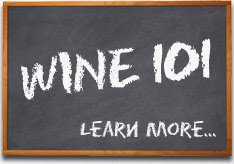Here are the main red varietals, what they contain and what they taste like.
Real Time Wine & WineStyle present: Red Wine Varietals. The Beginners Guide.
In red wines, we refer to something called tannins, which is the same texture found in tea. When the tannins are strong, you get that rasping feeling at the top of your mouth that makes you pucker, as if you had drunk tea that has been in the pot for too long.
Some varieties have more tannins than others, for example Cabernet Sauvignon has more tannin than Pinot Noir. So experiment with some of these varietals, and try to move out of your comfort zone of drinking Merlot all the time. There’s an exciting world out there!
Cabernet Sauvignon
Pronounced: Cab-air-nay-sow-veen-non
Cabernet Sauvignon is the king of red grapes. It ages beautifully and forms the backbone of many red blends. It smells of blackcurrants, cigar box, pencil shavings, green pepper and sometimes cinnamon and usually is a very serious wine. Cabernets have firm tannins and therefore aren't easy to drink young. However, with age the tannins soften and the wine can become silky and smooth.
Merlot
Pronounced: Mer-loh
Merlot is the soft and feminine version of Cabernet Sauvignon. It sometimes smells a little like Cabernet too but has more soft red fruit flavours such as blackberry and cherry. It often has a chocolate aroma to it and can be told apart from Cabernet by its much softer tannins, even at a young age. It is because Merlot is soft and approachable and juicy as soon as it is released that it is so popular.
Cabernet Franc
Pronounced: Cab-er-nay-franc
Many people do not know this varietal and traditionally it was used in blends only. Warwick Estate was the first to bottle Cabernet Franc as a single varietal and its popularity has since grown tremendously. It tastes like a really good Bloody Mary with Worcester sauce. Less attractive examples can have a green sort of grassy character, so it's best to choose a Cabernet Franc from a good producer. Its tannins are softer than those of Cabernet Sauvignon and the wine can be drunk much earlier.
Shiraz
Pronounced: Shir-az
Shiraz has grown in popularity over the last few years, partly because South Africa has been making really good Shiraz. In cooler climates, it gets a beautiful floral aroma and in warmer climates, it smells like raspberry jam, musk and fynbos. It is also popular because the tannins aren't too strong and the wine can be drunk quite young.
Pinot Noir
Pronounced: Pee-noh-nwaar
This is a wine that appears very gentle but is known as the “iron fist in the velvet glove”. It is instantly recognisable by its colour, which is like that of pale blackcurrant juice. Because of its colour, many assume that Pinot Noir is watery and bland. But Pinot Noir can pack a punch and on sipping it, a stack of flavours, from berries and liquorice to mushrooms and truffles, can emerge. The palate is usually silky smooth and very attractive. The biggest reason why Pinot Noir is not very popular in South Africa is that the good examples are really pricey.
Pinotage
Pronounced: Pee-no-tage
This is a truly South African grape. It is not really grown anywhere else in the world, save a few vineyards in a few countries where it is grown as a novelty. Pinotage is a cross between Pinot Noir and Cinsaut (a French grape we will not be discussing) and often tastes like banana or plums with a touch of coffee and chocolate. It is very popular in South Africa as it can either be easy drinking or very serious.
Bordeaux blend
Pronounced: Bored-oh
This is any red wine that contains one of the following varietals: Cabernet Sauvignon, Cabernet Franc, Merlot, Malbec (not discussed here) or Petit Verdot (not discussed here). There are a few wines in South Africa that contain all five but most contain only two or three. A Cabernet and Merlot blend, for instance, is a Bordeaux blend. The reason why these wines are blended is because the sum is better than the parts. In theory, blending them creates a more complex wine. This certainly is true of the top examples in the country. A good blend should be like a symphony, one should not be able to hear individual instruments, just beautiful music, so you should not be able to pick out the Cabernet or the Merlot – it should just taste like fantastic wine.
Cape blends
A Cape Blend is any red blend that contains Pinotage. In theory, it should contain between 30% and 70% Pinotage but many winemakers ignore this rule. Some Cape blends also contain Cabernet Sauvignon, Merlot or Shiraz, or all three. It is up to the winemaker to create something special.
Rhône blends
A Rhone blend contains one of the following varietals (many of them won't be discussed here): Shiraz, Grenache, Cinsaut or Mourvedre. Some even contain a little Viognier, which, despite being a white varietal, is traditionally added by winemakers in the Rhône valley to give their blends a more aromatic quality.
Italian blends
This blend contains any Italian varietal such as Nebbiolo, Sangiovese or Primitivo. Italian blends are becoming popular in South Africa and are often blended with other varietals like Cabernet Sauvignon or Merlot.
<> <> <>
The Wine 101 series is a collaboration between Real Time Wine and WineStyle Magazine. Content originally produced by WineStyle. Subscribe to their great newsletter and wine deals here. And whatever wine you're drinking, it's better to share it with your friends using Real Time Wine, the wine app for everyone who enjoys wine, not just those who understand it!


No comments:
Post a Comment